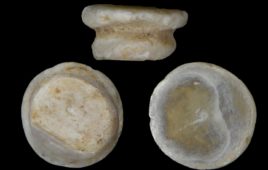.jpg)
A full-body scan showing the underside of the fish. Credit: Kevin Conway and Adam Summers
A new species of clingfish that has been stuck in a preserved jar in Australia since the 1970’s has finally been identified.
A team of scientists from the University of Washington, Texas A&M University and the Western Australian Museum have recently discovered a new genus and species of clingfish dubbed the duckbilled clingfish (Nettorhamphos radula) known for its broad, flat snout that houses a substantial amount of tiny, conical teeth.
“This fish has characteristics we just haven’t seen before in other clingfish. It’s the teeth that really gave away the fact that this is a new species,” lead author Kevin Conway, a fish taxonomist and associate professor at Texas A&M University, said in a statement.
The new clingfish was examined with particular interest because of their ability to stick to rough surfaces. The finger-sized fish could be useful in designing devices and instruments to be used in surgery or to tag and track whales in the ocean.
The species was discovered after Conway and co-author Glenn Moore of Western Australian Museum stumbled upon the new clingfish while looking through specimens preserved in jars at the museum in Welshpool, Australia. It is believed that the duckbilled clingfish has been preserved since 1977.
“A discovery like this highlights the importance of museum collections and reminds us just how much lies waiting to be uncovered,” Moore said in a statement. “Finding a previously unknown specimen in a jar is exciting but our collections of identified specimens are equally important so that we have something to compare against.”
The science team used a computerized tomography scanner to capture even finer details of the new clingfish than would be possible through manual dissection and also used the digital scans to 3D print parts of the fish in larger-than-life size to be able to analyze the mouth and jaw structures.
“This CT scan allowed us to take a completely noninvasive look at the entire skeleton of the fish and it produced a gorgeous set of morphological photos that you couldn’t get from dissection,” co-author Adam Summers of the University of Washington’s Friday Harbor Laboratories, said in a statement. “It’s a testament to the importance of using these noninvasive methods of data collection.”
The researchers honed in on the fish’s skeletal structure from several different angles and essentially digitally dissected parts of the fish.
The fish has an estimated 1,800 to 2,300 individual teeth—about 10 times of what all other known clingfish have.
The teeth point backward, which the researchers believe suggests a gripping function. However, that can’t be confirmed since the fish has never been observed in the wild.
While hundreds of new fish species are described each year, it is unusual for these new species to be placed in a new genus. For the duckbilled clingfish, the fish’s wider and longer upper jaw and abundance of tiny, dagger-like conical teeth were signs of a brand-new genus.
“I think it’s remarkable that we would add to this diversity with yet another new genus,” Conway said. “It’s pretty special given this fauna is already pretty well-studied.”




